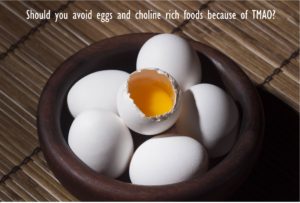
Should you pass on eating eggs because of TMAO?
Another TMAO study appears in July’s edition of the American Journal of Clinical Nutrition. Using the Nurses Health study cohort of over 120,000 individuals, higher intakes of phosphotidylcholine were associated with increased risk of death from all causes and cardiovascular disease, moreso in diabetics.
Trimethylamine-N-oxide is a product formed from the interaction of choline and carnitine with the intestinal environment and the liver. Choline and carnitine are two nutrients abundant primarily in meat, cheese and eggs.
Past studies have shown that feeding TMAO to rodents mucks up reverse cholesterol transport and causes kidney damage.
Does this happen in humans? Maybe. But unlikely. Consider that the food with the highest potential to increase TMAO in the bloodstream is fish. And fish consumption has repeatedly been shown to decrease risk of heart disease and other degenerative conditions.
Additionally, in a recent study looking at a German Adult population, those with the highest plasma concentration of TMAO had lower CRP and lower ratios of both total to HDL cholesterol and Triglyceride to HDL cholesterol. These two markers are known predictors of poor cardiovascular outcomes.
So yes. It’s true that there is a link between egg consumption, TMAO and heart disease. But it’s unlikely that TMAO sources from choline or carnitine containing foods play a causative role in disease. The TMAO factor at this point appears to be just noise.
Besides, eggs are rich in powerful nutritional factors which we will discuss for you later!
Eggs may need to be avoided for other reasons. Egg albumin is a common allergen for many. For others, its a source of really bad farts. You certainly want to be kind to those around you!
1. AJCN 2016: ajcn131771
2. Nat Med. 2013; 19(5):576-85
3. Circ Res. 2015; 116(3):448-55
4. J Food Comp 2002 15: 277-82
5. Food Chem Toxicol 1999; 37(5):515-20
6. JAMA 2006; 296(15):1885-1899
7. J Nutr 2016; 146(2): 283-9
8. www.globalheart-journal.com/article/s2211-8160(16)30020-5/pdf
Abstract OC06_01